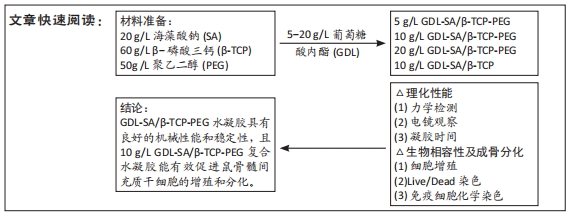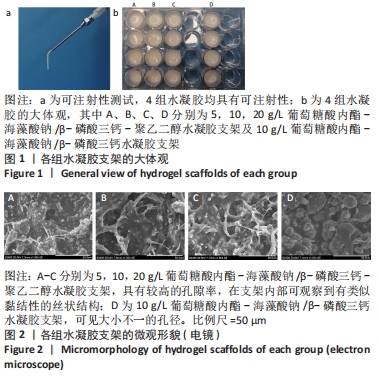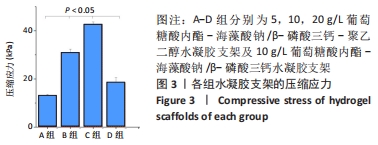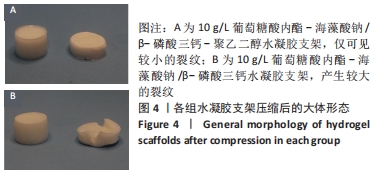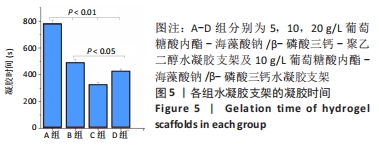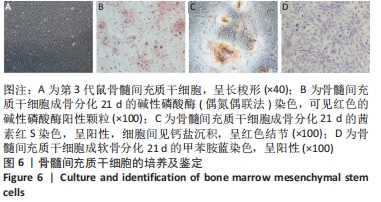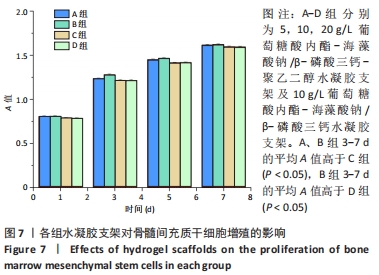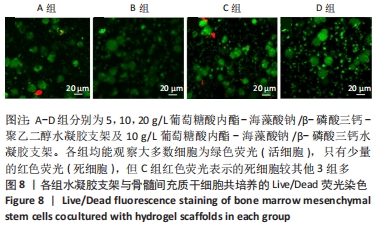[1] VISHNU PRIYA M, SIVSHANMUGAM A, BOCCACCINI AR, et al. Injectable osteogenic and angiogenic nanocomposite hydrogels for irregular bone defects. Biomed Mater. 2016;11(3):035017.
[2] PEñA B, LAUGHTER M, JETT S, et al. Injectable Hydrogels for Cardiac Tissue Engineering. Macromol Biosci. 2018;18(6):e1800079.
[3] SUHAIL M, KHAN A, ROSENHOLM J, et al. Fabrication and Characterization of Diclofenac Sodium Loaded Hydrogels of Sodium Alginate as Sustained Release Carrier. Gels. 2021;7(1):10.
[4] KIM S, THAMBI T, GIANG PHAN V, et al. Modularly engineered alginate bioconjugate hydrogel as biocompatible injectable scaffold for in situ biomineralization. Carbohydr Polym. 2020;233:115832.
[5] ANAMIZU M, TABATA Y. Design of injectable hydrogels of gelatin and alginate with ferric ions for cell transplantation. Acta Biomater. 2019; 100:184-190.
[6] DIAZ-RODRIGUEZ P, LóPEZ-ÁLVAREZ M, SERRA J, et al. Current Stage of Marine Ceramic Grafts for 3D Bone Tissue Regeneration. Mar Drugs. 2019;17(8):471.
[7] TAGHIPOUR Y, HOKMABAD V, DEL BAKHSHAYESH A, et al. The Application of Hydrogels Based on Natural Polymers for Tissue Engineering. Curr Med Chem. 2020;27(16):2658-2680.
[8] ABASALIZADEH F, MOGHADDAM S, ALIZADEH E, et al. Alginate-based hydrogels as drug delivery vehicles in cancer treatment and their applications in wound dressing and 3D bioprinting. J Biol Eng. 2020;14:8.
[9] GRIJALVO S, NIETO-DíAZ M, MAZA R, et al. Alginate Hydrogels as Scaffolds and Delivery Systems to Repair the Damaged Spinal Cord. Biotechnol J. 2019;14(12):e1900275.
[10] HAN Y, ZENG Q, LI H, et al. The calcium silicate/alginate composite: preparation and evaluation of its behavior as bioactive injectable hydrogels. Acta Biomater. 2013;9(11):9107-9117.
[11] GAO X, GAO L, GROTH T, et al. Fabrication and properties of an injectable sodium alginate/PRP composite hydrogel as a potential cell carrier for cartilage repair. J Biomed Mater Res A. 2019;107(9):2076-2087.
[12] HAN Y, ZENG Q, LI H, et al. The calcium silicate/alginate composite: preparation and evaluation of its behavior as bioactive injectable hydrogels. Acta Biomater. 2013;9(11):9107-9117.
[13] BIDARRA SJ, BARRIAS CC, GRANJA PL. Injectable alginate hydrogels for cell delivery in tissue engineering. Acta Biomater. 2014;10(4):1646-1662.
[14] GU Y, ZHANG J, ZHANG X, et al. Three-dimensional Printed Mg-Doped β-TCP Bone Tissue Engineering Scaffolds: Effects of Magnesium Ion Concentration on Osteogenesis and Angiogenesis In Vitro. Tissue Eng Regen Med. 2019;16(4):415-429.
[15] ZHANG Y, AN D, PARDO Y, et al. High-water-content and resilient PEG-containing hydrogels with low fibrotic response. Acta Biomater. 2017;53:100-108.
[16] 杜倩雯, 陈琳,钟春燕,等.BC/PVA/PEG增强型复合水凝胶的制备及其表征[J].广东化工,2014, 41(16):17-18.
[17] 乔从德.聚乙二醇基智能水凝胶的研究进展[J].高分子通报,2010 (3):23-30.
[18] YANG C, GAO L, LIU X, et al. Injectable Schiff base polysaccharide hydrogels for intraocular drug loading and release. J Biomed Mater Res A. 2019;107(9): 1909-1916.
[19] REN B, CHEN X, DU S, et al. Injectable polysaccharide hydrogel embedded with hydroxyapatite and calcium carbonate for drug delivery and bone tissue engineering. Int J Biol Macromol. 2018;118(Pt A):1257-1266.
[20] YUAN Z, WEI P, HUANG Y, et al. Injectable PLGA microspheres with tunable magnesium ion release for promoting bone regeneration. Acta Biomater. 2019;85:294-309.
[21] BI X, MATURAVONGSADIT P, TAN Y, et al. Polyamidoamine dendrimer-PEG hydrogel and its mechanical property on differentiation of mesenchymal stem cells. Biomed Mater Eng. 2019;30(1):111-123.
[22] HERNáNDEZ-GONZáLEZ A, TéLLEZ-JURADO L, RODRíGUEZ-LORENZO LJ CP. Alginate hydrogels for bone tissue engineering, from injectables to bioprinting: A review. Carbohydr Polym. 2020;229:115514.
[23] NAM S, STOWERS R, LOU J, et al. Varying PEG density to control stress relaxation in alginate-PEG hydrogels for 3D cell culture studies. Biomaterials. 2019;200:15-24.
[24] ZHOU Y, ZHANG J, YANG J, et al. Kartogenin with PRP promotes the formation of fibrocartilage zone in the tendon-bone interface. J Tissue Eng Regen Med. 2017;11(12):3445-3456.
[25] LIU G, ZHOU H, WU H, et al. Preparation of alginate hydrogels through solution extrusion and the release behavior of different drugs. J Biomater Sci Polym Ed. 2016;27(18):1808-1823.
[26] ALIPOUR M, AGHAZADEH M, AKBARZADEH A, et al. Towards osteogenic differentiation of human dental pulp stem cells on PCL-PEG-PCL/zeolite nanofibrous scaffolds. Artif Cells Nanomed Biotechnol. 2019; 47(1):3431-3437.
[27] ZHU T, GU H, ZHANG H, et al. Covalent grafting of PEG and heparin improves biological performance of electrospun vascular grafts for carotid artery replacement. Acta Biomater. 2021;119:211-224.
[28] WANG H, XU Y, WANG P, et al. Cell-mediated injectable blend hydrogel-BCP ceramic scaffold for in situ condylar osteochondral repair. Acta Biomater. 2021;123:364-378.
[29] CASTILLO L, GUERRERO C, ACOSTA O. Expression of typical osteoclast markers by PBMCs after PEG-induced fusion as a model for studying osteoclast differentiation. J Mol Histol. 2017;48(3):169-185.
|
